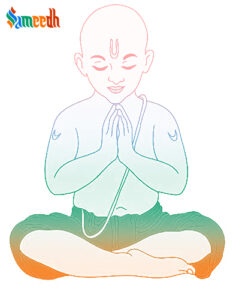10th of 16 sanskars – this is the second birth, the intellectual birth of the child. Child, with the permission of parents, elders and Goddess Gayatri, accepts a janoi / janeu – three thread set, to steadfast the belief that God is always with me. It is also Vedarambha – beginning of studying Vedic scriptures.

The Yajnopavita, also known as the sacred thread, is a significant symbol in Hinduism, especially among the Brahmin community, as a symbol of initiation and a commitment to spiritual and moral duties. The ceremony associated with it is known as the Upanayana or Thread Ceremony. This ceremony marks the initiation of a young boy into the study of the Vedas and the beginning of his formal education. The ceremony is typically conducted by the boy’s father or a qualified priest. Here are the key aspects of the Yajnopavita Sanskar or Thread Ceremony:
1. Timing:
- The Upanayana ceremony is traditionally performed at a specific age, often between 7 and 16 years, depending on the community and region. The ceremony is more commonly associated with boys, but in some communities, it is also performed for girls.
2. Significance:
- The Yajnopavita is a sacred thread made of cotton, symbolizing purity, and it has three strands that represent various aspects of life and duty. The ceremony marks the beginning of the student’s journey into the study of the Vedas and signifies his commitment to leading a disciplined and virtuous life.
3. Rituals:
- The rituals associated with the Yajnopavita Sanskar may vary based on regional customs and traditions. Some common elements include purification ceremonies, prayers, and the chanting of Vedic mantras. The main part of the ceremony involves the investiture of the sacred thread.
4. Investiture of the Thread:
- During the ceremony, the father or the officiating priest invests the sacred thread around the boy’s left shoulder and under the right arm. This way, the thread rests diagonally across the chest. This act symbolizes the boy’s acceptance of the responsibilities and duties associated with his new stage of life.
5. Mantras and Teachings:
- Various mantras, especially those associated with the Gayatri mantra, may be recited during the ceremony. The boy is also taught the significance of the thread, the responsibilities he is undertaking, and the importance of leading a righteous life.
6. Change in Status:
- The Upanayana ceremony marks a change in the social and spiritual status of the individual. After the ceremony, the young boy is considered a “Dvija” or twice-born, signifying his rebirth into a higher, spiritually oriented life.
7. Post-Ceremony Activities:
- Following the ceremony, the young boy is expected to adhere to certain rules and practices, including daily rituals and the chanting of specific mantras. He is encouraged to pursue education, particularly in the study of the Vedas.
8. Cultural and Regional Variations:
- The details of the ceremony can vary significantly among different Hindu communities and regions. The emphasis and specific rituals may differ based on cultural traditions and the family’s background.
The Yajnopavita Sanskar is a significant rite of passage in Hinduism, emphasizing the importance of education, discipline, and the pursuit of spiritual knowledge. It is a tradition that has been passed down through generations and continues to be an integral part of Hindu culture.
